LINKSYS EA3500 High Performance Dual-Band N Router User Manual E Series Router Cert E3500
LINKSYS LLC High Performance Dual-Band N Router E Series Router Cert E3500
LINKSYS >
Contents
- 1. User Manual - Operation
- 2. User Manual - Statements
User Manual - Operation
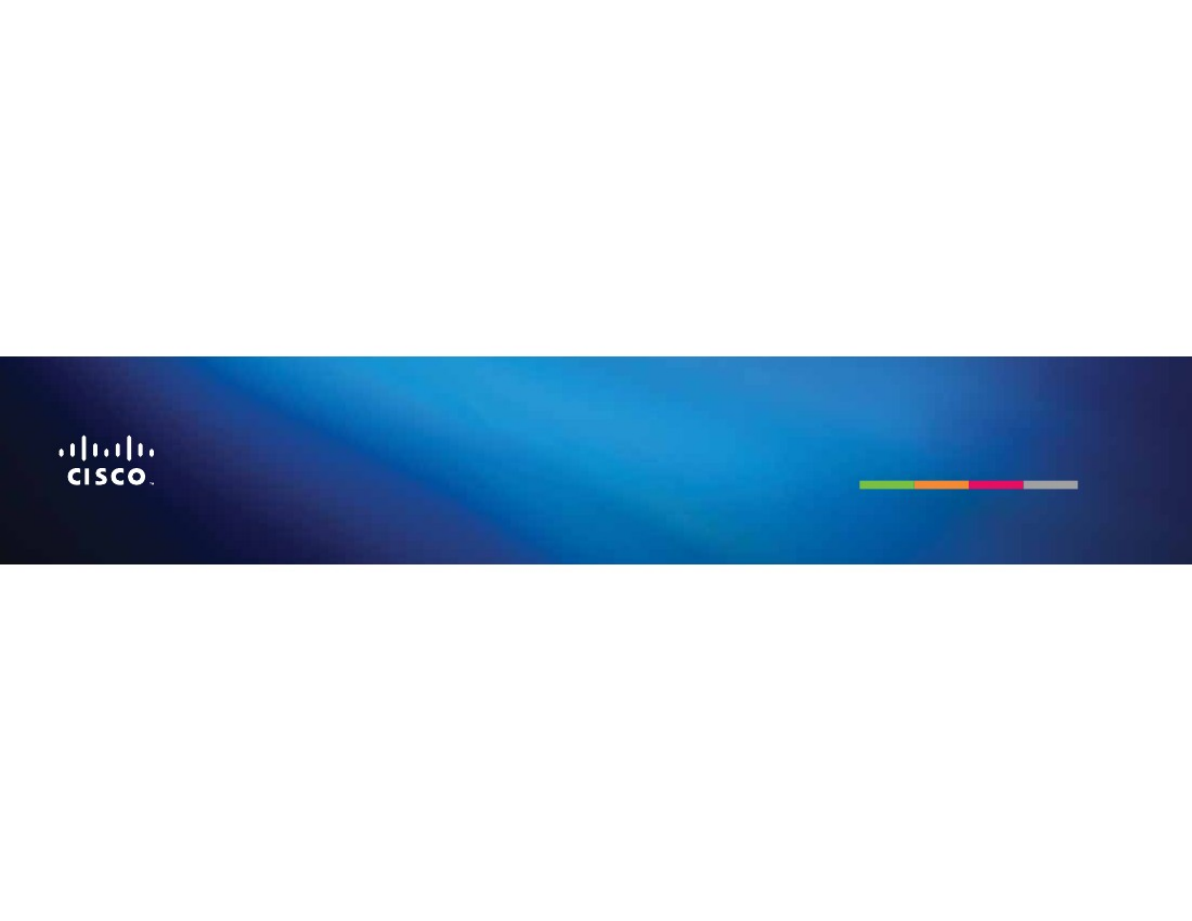
Linksys E-Series Routers

Linksys E-Series
Table of Contents
Table of Contents
Product overview
E1200/E1500/E2500/E3500
Back view
Bottom view
Wireless Security
1
1
1
Wireless > Wireless Security
Personal options
Office options
Option settings
8
8
8
8
E4200
Top view
Back view
2
2
2Troubleshooting
How to run Cisco Connect after setup
Your router was not successfully set up
Get Windows XP Service Pack 3 message
Your Internet cable is not plugged in message
Cannot access your router message
Device not found message
11
12
12
13
14
15
Setting Up Your E-Series Router
Where to find more help
How to set up your router
How to start Cisco Connect
Use Cisco Connect to manage your router
3
3
3
3
How to manually set up your router 3
Advanced Configuration
How to open the browser-based utility
Setup > Basic Setup
Language
Internet Setup
Specifications
4
5
5
5
Wireless > Basic Wireless Settings
Wireless Settings 6
6
Linksys E1200
Linksys E1500
Linksys E2500
Linksys E3500
Linksys E4200
17
18
19
20
21
i
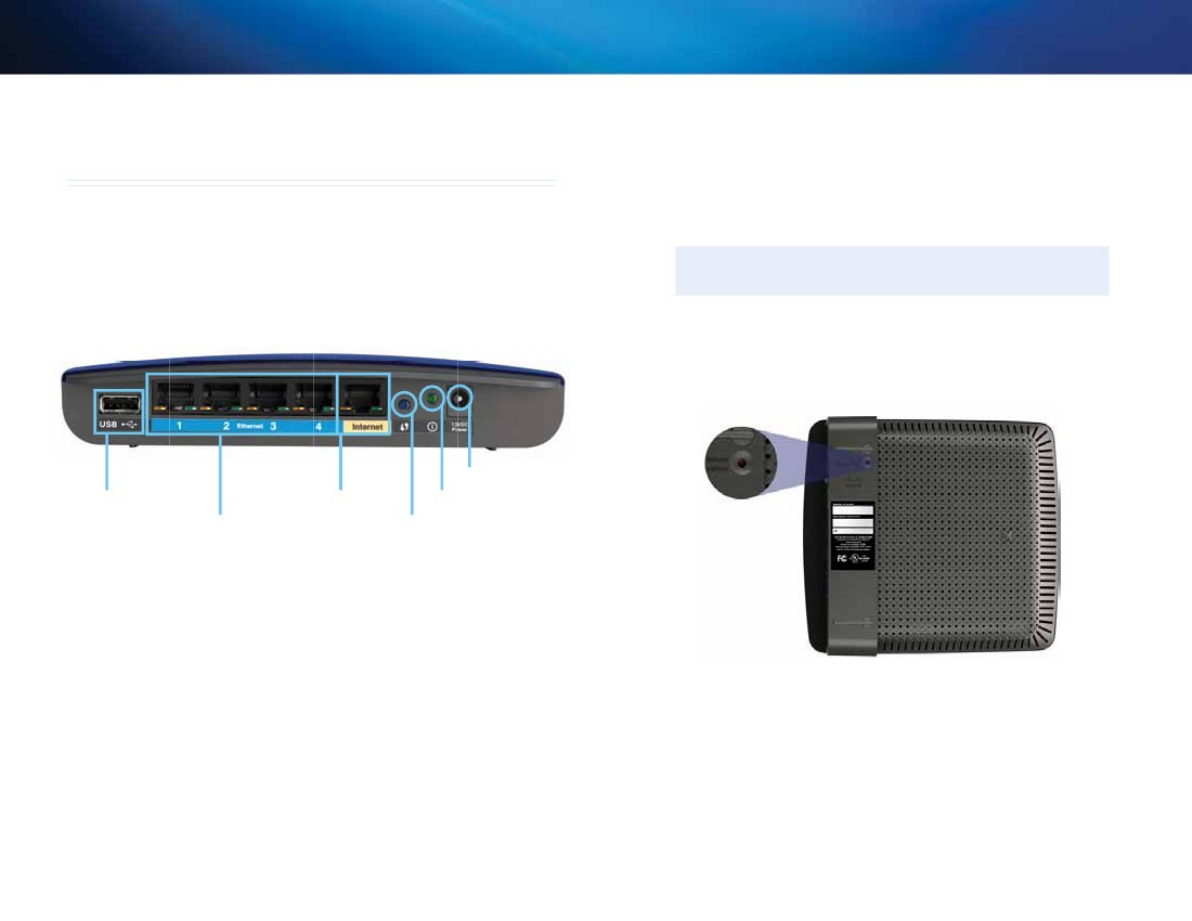
Linksys E-Series
Product overview
•
Product overview
E1200/E1500/E2500/E3500
Back view
Power indicator—Stays on steadily while power is connected and
following a successful Wi-Fi Protected Setup connection Flashes slowly
during bootup, during firmware upgrades, and during a Wi-Fi Protected
Setup connection Flashes quickly when there is a Wi-Fi Protected Setup
error
Power—Connect the included AC power adapter to this port
CAUTION
Use only the adapter that came with your router
•
•Power button—Press | (on) to turn on the router
Bottom view
Power port
USB port (E3500 only)
Ethernet ports
Internet port Power indicator
Wi-Fi Protected Setup button
Your router’s appearance may vary
•
•
USB port (E3500 only)—To easily share disk storage with other users on
your network or on the Internet, connect a USB drive to this port
Ethernet ports—Connect Ethernet cables (also called network
cables) to these Fast Ethernet (10/100, for E1200 and E1500) or Gigabit
(10/100/1000, for E2500 and E3500) ports, color coded blue, and to other
wired Ethernet network devices on your network
Internet port—Connect an Ethernet cable (also called a network or
Internet cable) to this port, color coded yellow, and to your modem
Wi-Fi Protected Setup™ button—Press this button to easily configure
wireless security on Wi-Fi Protected Setup-enabled network devices For
more information, see “Wireless Security” on page 8
•
Your router’s appearance may vary
• Reset button—Press and hold this button for 5-10 seconds (until the
p
ort lights flash at the same time) to rese
t
the router to its factory defaults
You can also restore the defaults using the browser-based utility
1
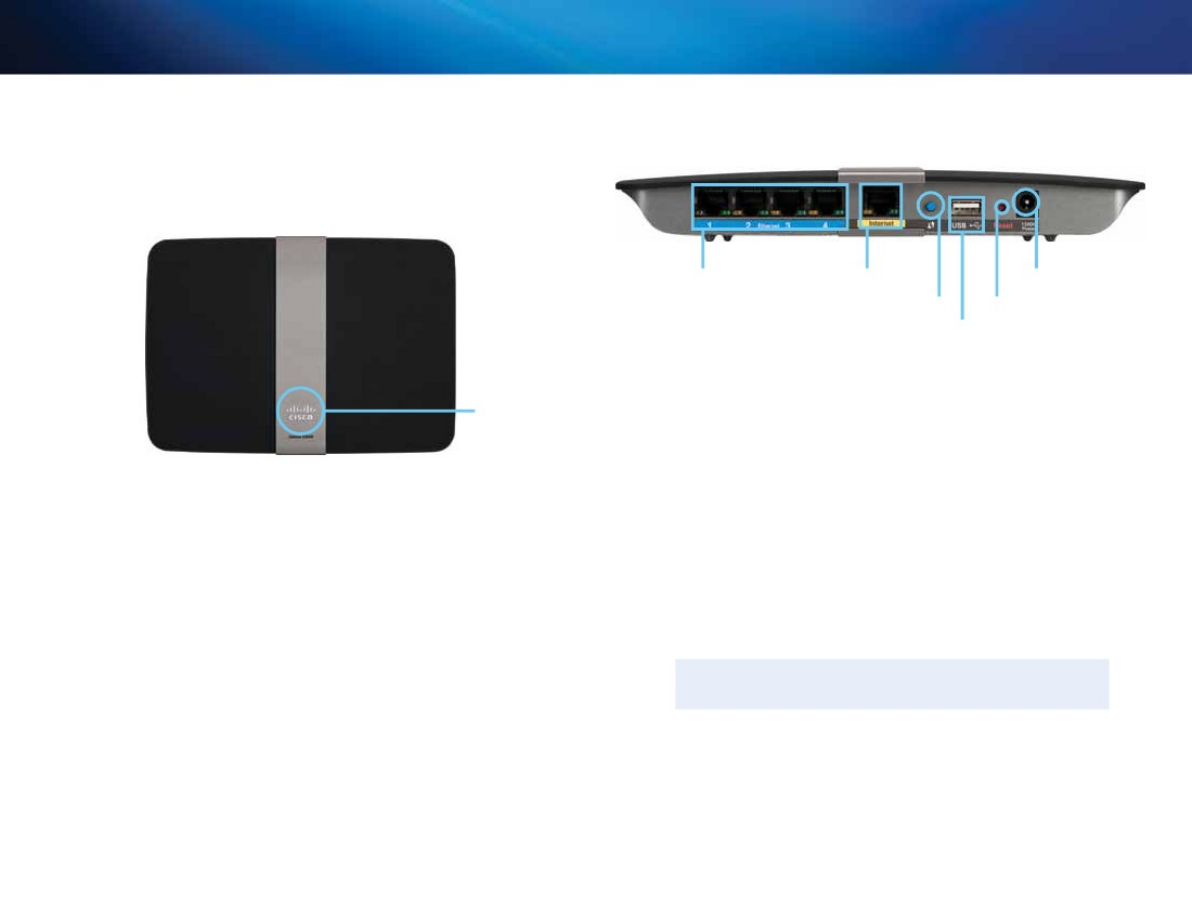
Linksys E-Series
Product overview
Back view
E4200
Top view
Ethernet ports Internet port
Wi-Fi Protected Setup button
Power port
Reset button
USB port
•
Indicator light
Ethernet ports—Connect Ethernet cables (also called network cables)
to these Gigabit (10/100/1000) ports, color coded blue, and to other
wired Ethernet network devices on your network
Internet port—Connect an Ethernet cable (also called a network or
Internet cable) to this port, color coded yellow, and to your modem
Wi-Fi Protected Setup™ button—Press this button to easily configure
wireless security on Wi-Fi Protected Setup-enabled network devices For
more information, see “Wireless Security” on page 8
USB port—To easily share disk storage with other users on your network
or on the Internet, connect a USB drive to this port
Reset button—Press and hold this button for 5-10 seconds (until the
p
ort lights flash at the same time) to reset the router to its factory defaults
You can also restore the defaults using the browser-based utility
Power—Connect the included AC power adapter to this port
CAUTION
Use only the adapter that came with your router
•
•
• Indicator light—Stays on steadily while power is connected and
following a successful Wi-Fi Protected Setup connection Pulses slowly
during bootup, during firmware upgrades, and during a Wi-Fi Protected
Setup connection Flashes quickly when there is a Wi-Fi Protected Setup
error •
•
•
•Power button—Press | (on) to turn on the router
2

Linksys E-Series
Setting Up Your E-Series Router
Setting Up Your E-Series Router
Where to find more help
In addition to this User Guide, you can find help at these locations:
•
•
•
To start Cisco Connect for the first time:
1 . Insert the CD into your CD or DVD drive
2 . Click Set up your Linksys Router
If you do not see this:
•
•
Linksys.com/support (documentation, downloads, FAQs, technical
support, live chat, forums)
Cisco Connect help (run Cisco Connect, then click Learn More where
available)
Browser-based utility context-sensitive help (open the utility, then click
Help in the right-side column )
For Windows, click Start, Computer, then double-click the CD drive
and the Setup icon
For Mac, double-click the CD icon on your desktop, then double-click
the Setup icon
3 . Follow the on-screen instructions to complete your router setup
How to set up your router
The easiest and fastest way to set up your router is to run the Cisco Connect
setup software
Use Cisco Connect to manage your router
After your router has been set up and Cisco Connect has been installed, you
can use Cisco Connect to easily manage many of your router’s settings such as:
•
•
•
•
•
How to start Cisco Connect
When you run the setup CD, Cisco Connect (your router’s setup software) is
automatically installed onto your computer You can then use Cisco Connect to
easily manage your router
N
OTE:
If you lose your setup CD, you can download the software from
Linksys.com/support
Connect devices to your network
Test your Internet connection speed
Configure parental controls
Set up guest access
Change your router’s name and password
How to manually set up your router
After setting up the router with the setup software (located on the CD), the
router will be ready for use If you would like to change its advanced settings,
or if the software does not run, use the router’s browser-based utility You can
access the utility with a web browser on a computer connected to the router
For more information on using the utility, see “How to open the browser-based
utility” on page 4
3
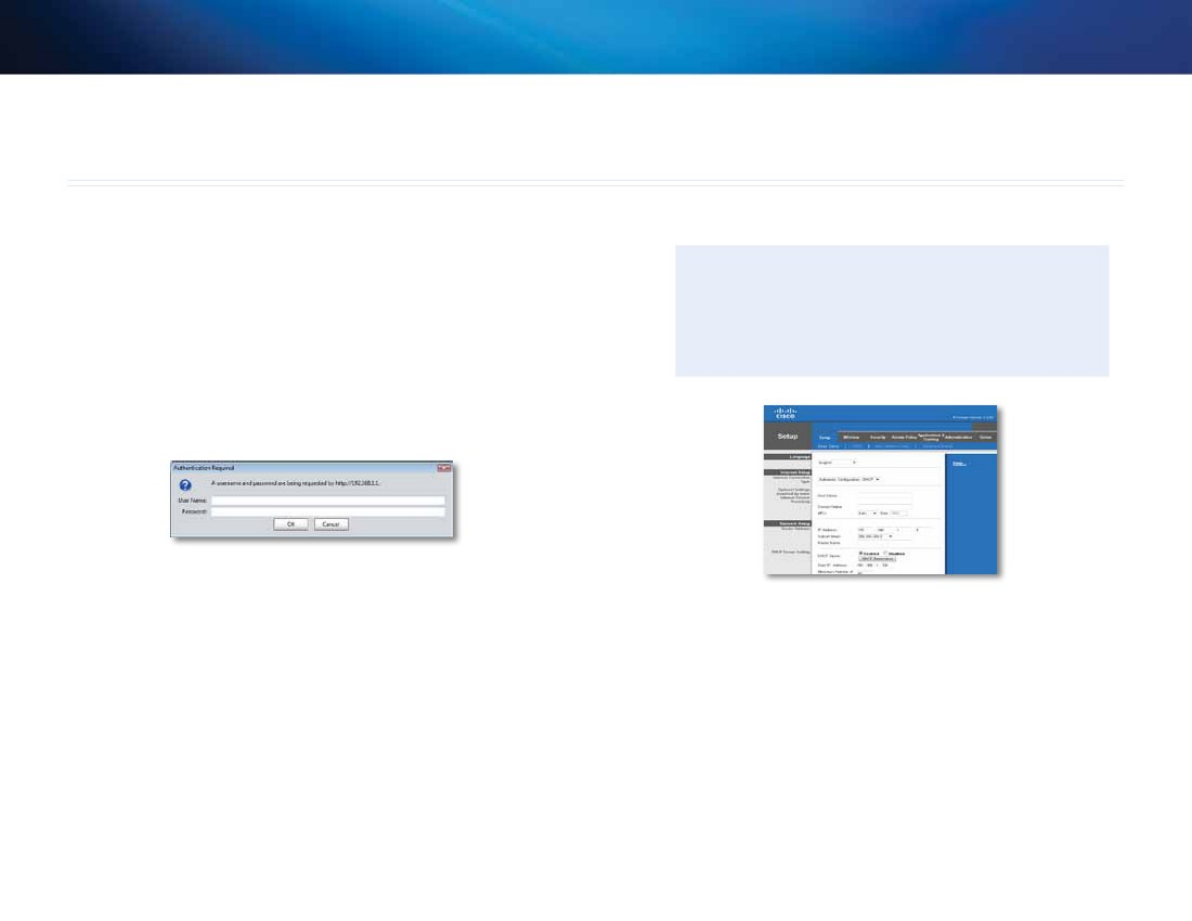
Linksys E-Series
Advanced Configuration
Advanced Configuration
How to open the browser-based utility
To access some advanced settings, you need to open the browser-based utility
To open the browser-based utility:
1 . Run Cisco Connect, click Change under Router settings, click Advanced
settings, then click oK
–
or –
Open a web browser on a computer connected to your network, then go
to 192.168.1.1
The router prompts you for a user name and password
2 . Enter the user name and password, then click oK The utility’s main menu
opens
TIPS
If you set up your router without using Cisco Connect, your router’s
default password is admin (You can leave the user name blank )
If you used Cisco Connect to set up your router, you can see your
router’s user name and password by running Cisco Connect, then
clicking Router settings
4
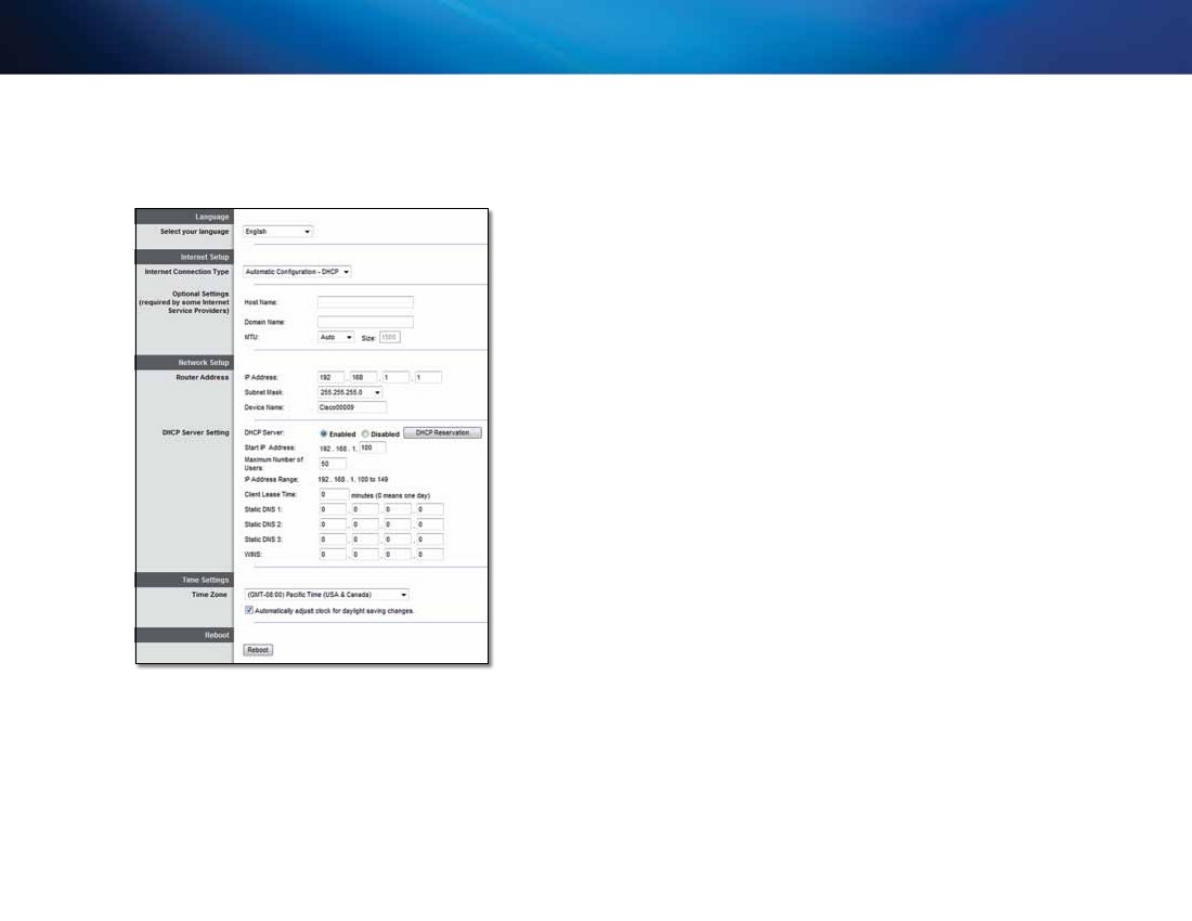
Linksys E-Series
Advanced Configuration
Language
Select your language To use a different language, select one from the drop-
down menu The language of the browser-based utility will change five seconds
after you select another language
Setup > Basic Setup
The first screen that appears is the Basic Setup screen This allows you to change
the router’s general settings
Internet Setup
The Internet Setup section configures the router to your Internet connection
Most of this information can be obtained through your Internet Service
Provider (ISP)
Internet Connection Type
Select the type of Internet connection your ISP provides from the drop-down
menu The available types are:
•
•
•
•
•
•
Automatic Configuration - DHCP
Static IP
PPPoE
PPTP
L2TP
Telstra Cable
Automatic Configuration - DHCP
The default Internet Connection Type is Automatic Configuration - DHCP
(Dynamic Host Configuration Protocol) Keep the default only if your ISP
supports DHCP or if you connect using a dynamic IP address (This option
usually applies to cable connections )
Static IP
If you are required to use a fixed IP address to connect to the Internet, select
Static IP
PPPoE
If you have a DSL connection, check whether your ISP uses Point-to-Point
Protocol over Ethernet (PPPoE) If so, select PPPoE
5
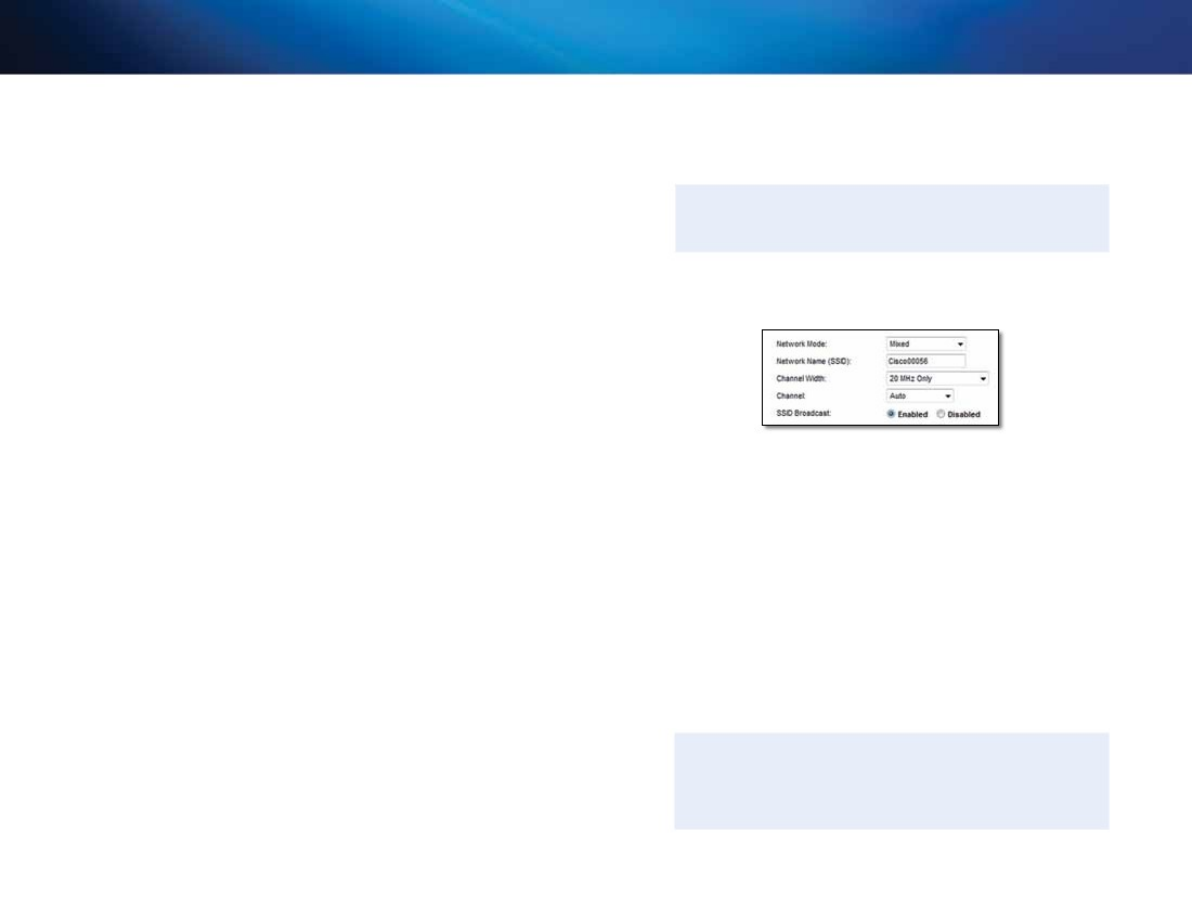
Linksys E-Series
PPTP
Point-to-Point Tunneling Protocol (PPTP) is a service that generally applies to
connections in Europe If your PPTP connection supports DHCP or a dynamic IP
address, then select obtain an IP Address Automatically If you are required
to use a fixed IP address to connect to the Internet, then select Specify an IP
Address and configure the options below
Advanced Configuration
Wireless > Basic Wireless Settings
The basic settings for wireless networking are set on this screen
N
OTE
After you set up the wireless network(s), set up the wireless security
settings
L2TP
Layer 2 Tunneling Protocol (L2TP) is a service that generally applies to
connections in Israel Wireless Settings
Telstra Cable
Telstra Cable is a service that generally applies to connections in Australia
Connect on Demand or Keep Alive
The Connect on Demand and Keep Alive options let you choose whether
the router connects to the Internet only as needed (useful if your ISP charges
for connect time), or if the router should always be connected Select the
appropriate option
network Mode Select the wireless standards your network will support
•
•
•
•
•
•
Mixed If you have Wireless-N (2 4 GHz), Wireless-G, and Wireless-B devices
in your network, keep the default, Mixed
Wireless-B/G only If you have both Wireless-B and Wireless-G (2 4 GHz)
devices in your network, select Wireless-B/G only
Wireless-B only If you have only Wireless-B devices, select Wireless-B
only
Wireless-G only If you have only Wireless-G devices, select Wireless-G
only
Wireless-n only If you have only Wireless-N (2 4 GHz) devices, select
Wireless-n only
Disabled If you have no Wireless-B, Wireless-G, and Wireless-N (2 4 GHz)
devices in your network, select Disabled
N
OTE
If you have a dual-band router, you can select Mixed, Wireless-A
Only, Wireless-N Only, or Disabled for the 5 GHz band
If you are not sure which mode to use, keep the default, Mixed
6

Linksys E-Series
network name (SSID) The Service Set Identifier (SSID) is the network name
shared by all devices in a wireless network It is case-sensitive and must not
exceed 32 keyboard characters The default is Cisco followed by the last 5 digits
of the router’s serial number, which is found on the bottom of the router If
you used the setup software for installation, then the default Network Name is
changed to an easy-to-remember name
N
OTE
If you restore the router’s factory default settings (by pressing
the Reset button or using the Administration > Factory Defaults
screen), the Network Name will return to its default value Change
the Network Name back to its original name, or you will have to
reconnect all devices on your wireless network to the new network
name
Channel Width For best performance in a network using Wireless-B,
Wireless-G and Wireless-N (2 4 GHz) devices, select Auto (20 MHz or 40 MHz)
For a channel width of 20 MHz, keep the default, 20 MHz only
Channel Select the channel from the drop-down list for Wireless-B, Wireless-G,
and Wireless-N (2 4 GHz) networking If you are not sure which channel to
select, then keep the default, Auto
SSID Broadcast When wireless clients survey the local area for wireless
networks to associate with, they will detect the SSID broadcast by the router
To broadcast the router’s SSID, keep the default, Enabled If you do not want to
broadcast the router’s SSID, then select Disabled
Advanced Configuration
7
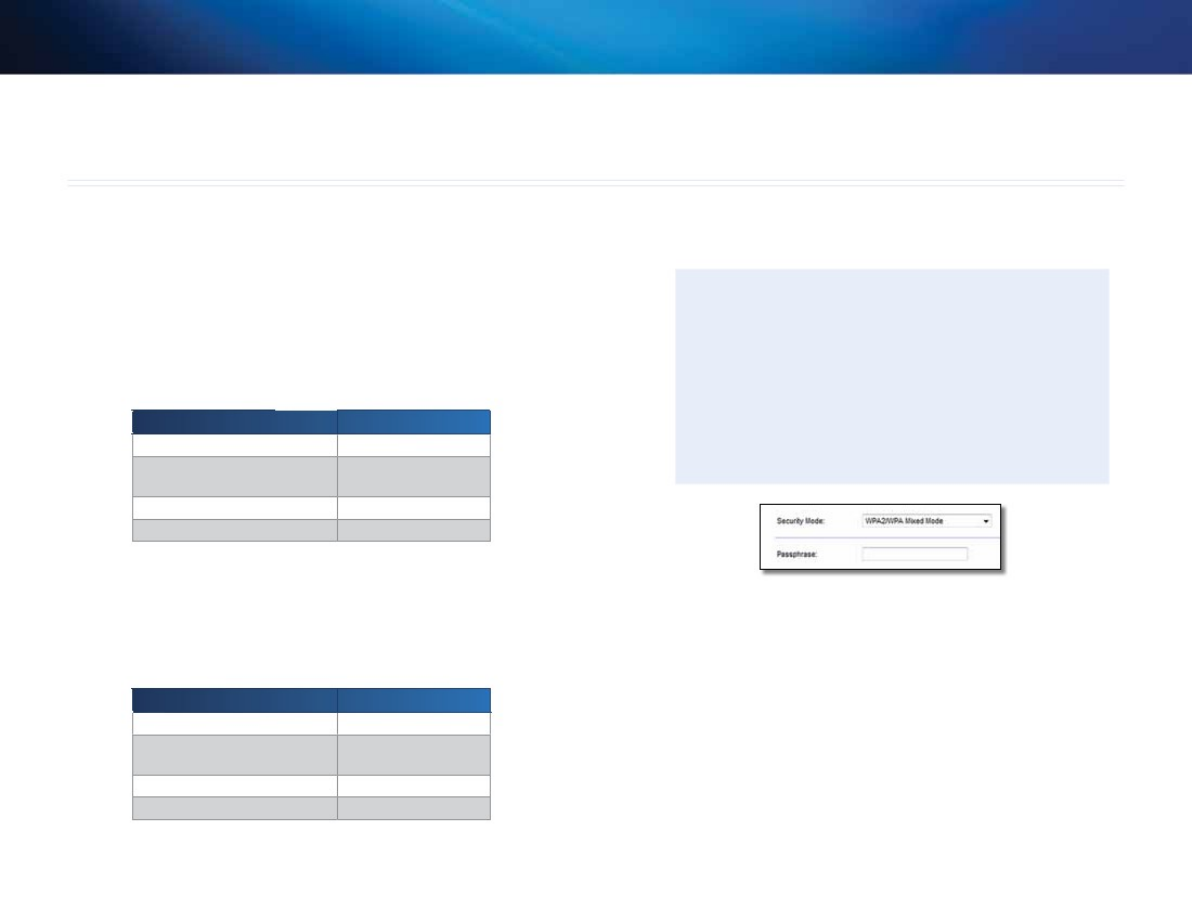
Linksys E-Series
Wireless Security
Wireless Security
Wireless > Wireless Security
The wireless security settings configure the security of your wireless network(s)
The router supports the following wireless security options: WPA2/WPA Mixed
Mode, WPA2 Personal, WPA Personal, WPA2/WPA Enterprise Mixed Mode, WPA2
Enterprise, WPA Enterprise, WEP, and RADIUS (WPA stands for Wi-Fi Protected
Access WEP stands for Wireless Equivalent Privacy RADIUS stands for Remote
Authentication Dial-In User Service )
Option settings
WPA2/WPA Mixed Mode, WPA2 Personal, WPA Personal
N
OTES
If you select WPA2/WPA Mixed Mode as your Security Mode, each
device in your wireless network MUST use WPA2/WPA and the
same passphrase
If you select WPA2 Personal as your Security Mode, each device
in your wireless network MUST use WPA2 Personal and the same
p
assphrase
Personal options
Security option
WPA2 Personal
WPA2/WPA Mixed Mode
WPA Personal
WEP
Strength
Strongest
WPA2: Strongest
WPA: Strong
Strong
Basic
If you select WPA Personal as your Security Mode, each device
in your wireless network MUST use WPA Personal and the same
p
assphrase
Office options
The office options are available for networks that use a RADIUS server
for authentication The office options are stronger than the personal
options because WPA2 or WPA provides encryption while RADIUS provides
authentication
Security option
WPA2 Enterprise
WPA2/WPA Enterprise Mixed
Mode
WPA Enterprise
RADIUS
Passphrase Enter a passphrase of 8-63 characters The default is password If
you used the setup software for installation, then the default is changed to a
unique passphrase, which you can find by running Cisco Connect, then clicking
Router settings
Strength
Strongest
WPA2: Strongest
WPA: Strong
Strong
Basic
8
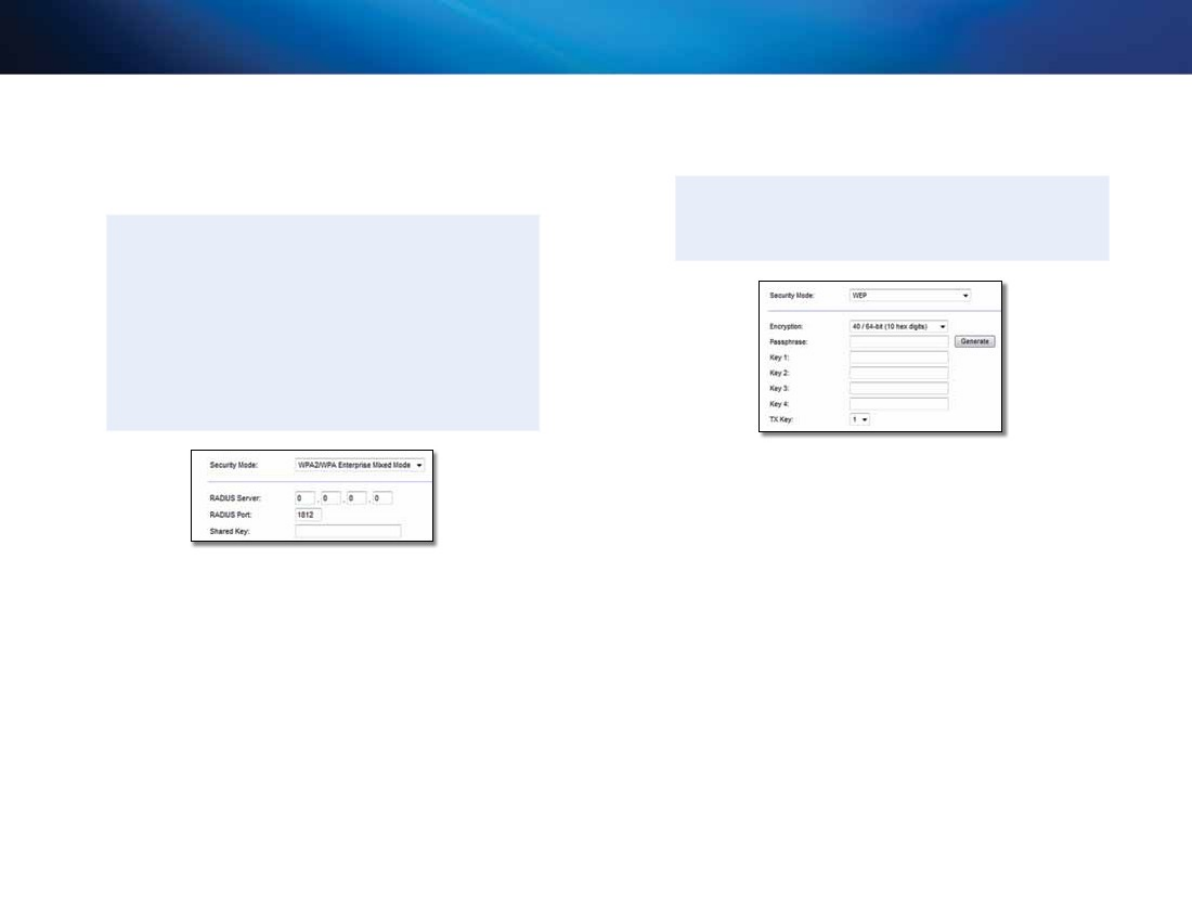
Linksys E-Series
WPA2/WPA Enterprise Mixed Mode, WPA2 Enterprise, WPA
Enterprise
These option is used in coordination with a RADIUS server (These should only
be used when a RADIUS server is connected to the router )
N
OTES
If you select WPA2/WPA Enterprise Mixed Mode as your Security
Mode, each device in your wireless network MUST use WPA2/WPA
Enterprise and the same shared key
If you select WPA2 Enterprise as your Security Mode, each device
in your wireless network MUST use WPA2 Enterprise and the same
shared key
If you select WPA Enterprise as your Security Mode, each device
in your wireless network MUST use WPA Enterprise and the same
shared key
Wireless Security
WEP
WEP is a basic encryption method, which is not as secure as WPA
N
OTE:
If you select WEP as your Security Mode, each device in your
wireless network MUST use WEP and the same encryption and
shared key
Encryption Select a level of WEP encryption, (40/64-bit 10 hex digits) or
104/128-bit (26 hex digits) The default is 40/64-bit (10 hex digits)
Passphrase Enter a passphrase to automatically generate WEP keys Then
click Generate
Key 1-4 If you did not enter a passphrase, enter the WEP key(s) manually
RADIUS Server Enter the IP address of the RADIUS server
RADIUS Port Enter the port number of the RADIUS server The default is 1812
Shared Key Enter the key shared between the router and the server
TX Key Select a default TX (Transmit) Key to use The default is 1
9
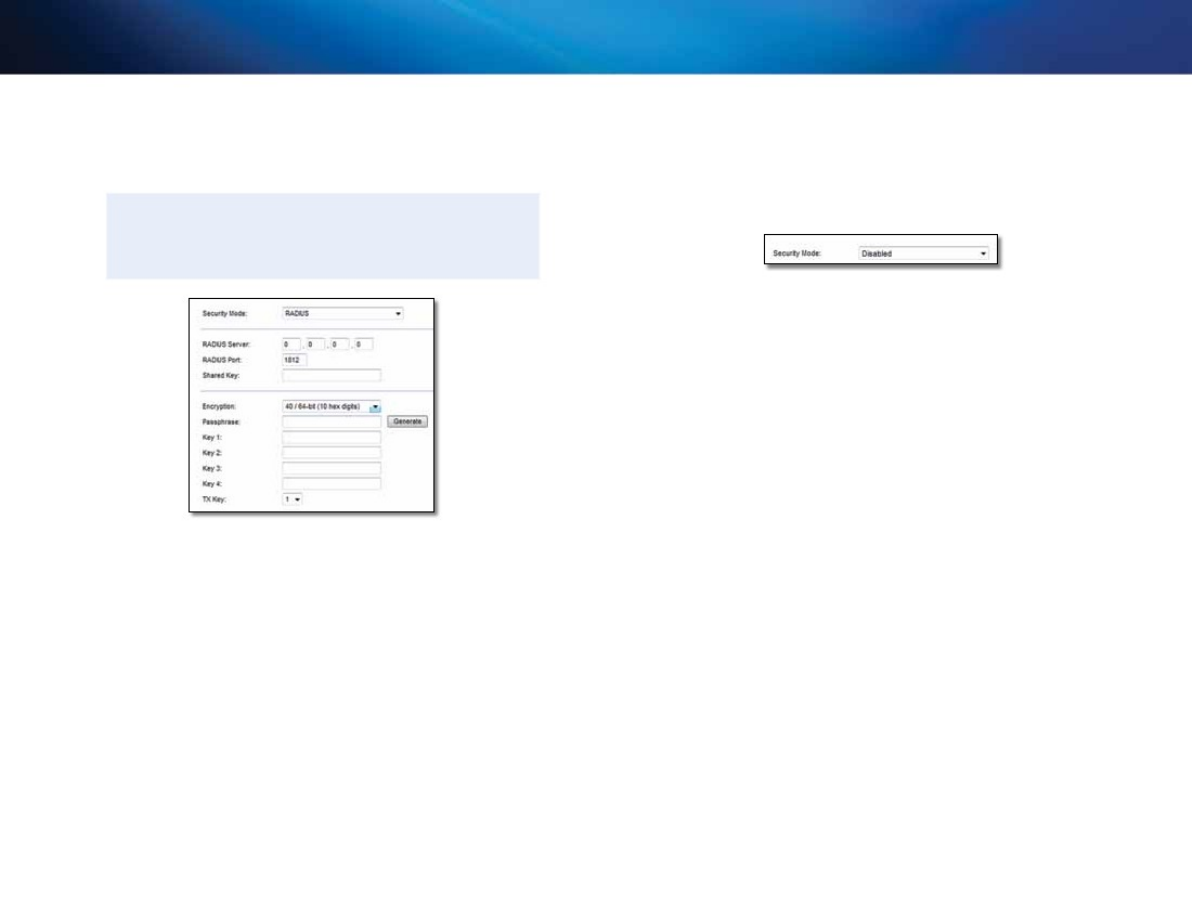
Linksys E-Series
RADIUS
This option features WEP used in coordination with a RADIUS server (This
should only be used when a RADIUS server is connected to the router )
N
OTE:
If you select RADIUS as your Security Mode, each device in your
wireless network MUST use RADIUS and the same encryption and
shared key
Wireless Security
Disabled
If you choose to disable wireless security, you will be informed that wireless
security is disabled when you first attempt to access the Internet You will given
the option to enable wireless security, or confirm that you understand the risks
but still wish to proceed without wireless security
RADIUS Server Enter the IP address of the RADIUS server
RADIUS Port Enter the port number of the RADIUS server The default is 1812
Shared Secret Enter the key shared between the router and the server
Encryption Select a level of WEP encryption, (40/64-bit 10 hex digits) or
104/128-bit (26 hex digits) The default is 40/64-bit (10 hex digits)
Passphrase Enter a passphrase to automatically generate WEP keys Then
click Generate
Key 1-4 If you did not enter a passphrase, enter the WEP key(s) manually
TX Key Select a default TX (Transmit) Key to use The default is 1
10
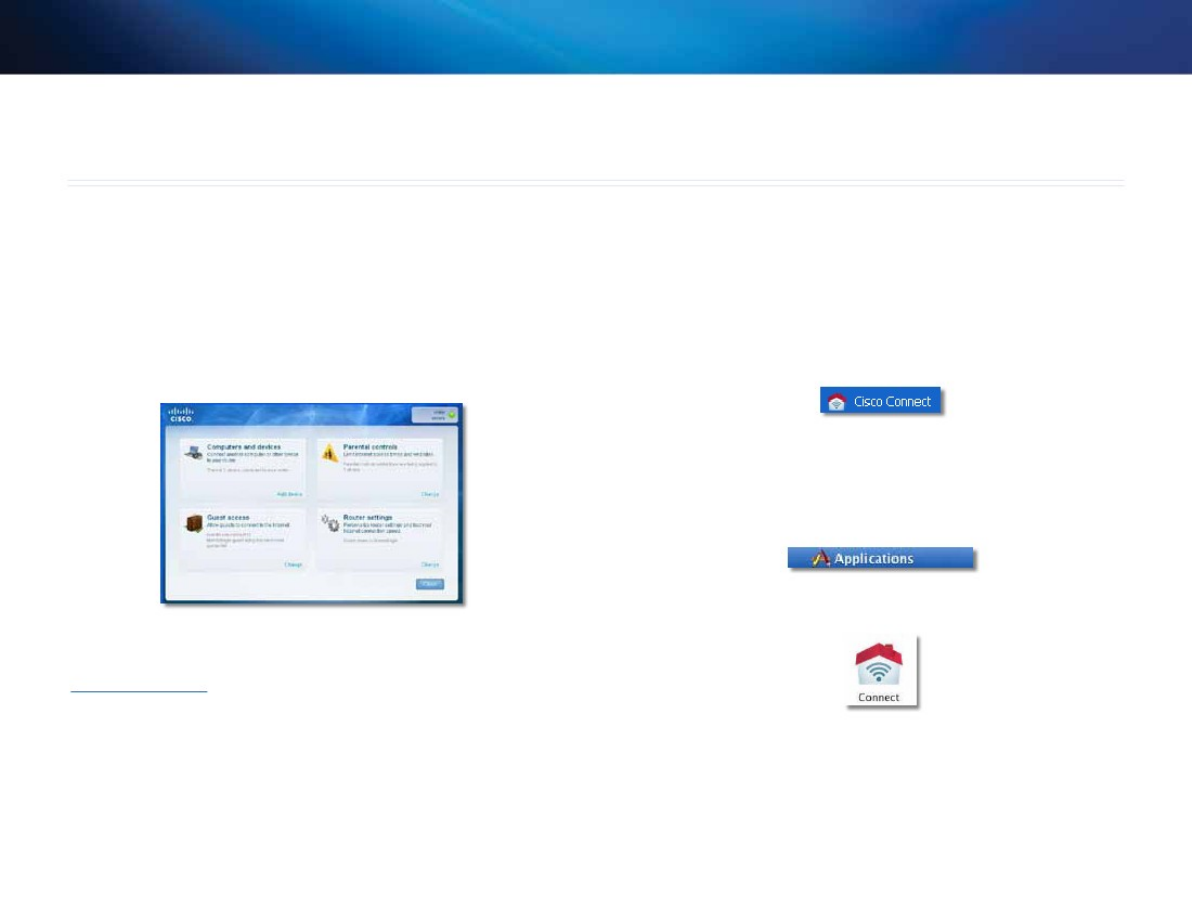
Linksys E-Series
Troubleshooting
Troubleshooting
This chapter can help you solve common setup issues and connect to the
Internet Your router’s CD includes Cisco Connect, the router setup software
that makes it easy to connect network devices, change router settings, control
guest access, enable parental controls, and connect to the Internet Cisco
Connect is also installed onto your computer during setup If Cisco Connect
is prevented from completing the setup, this chapter will guide you through
finding solutions
How to run Cisco Connect after setup
When you run the setup CD, Cisco Connect is automatically installed onto your
computer You can then use Cisco Connect to easily manage your network
To start Cisco Connect on a Windows computer:
1 . Click Start, All Programs, then click Cisco Connect
The Cisco Connect main menu opens
To start Cisco Connect on a Mac oS X computer:
1 . Open Finder and click Applications in the left panel
2 . Double-click the Cisco Connect icon
You can find more help from our award-winning customer support at
linksys.com/support.
The Cisco Connect main menu opens
11
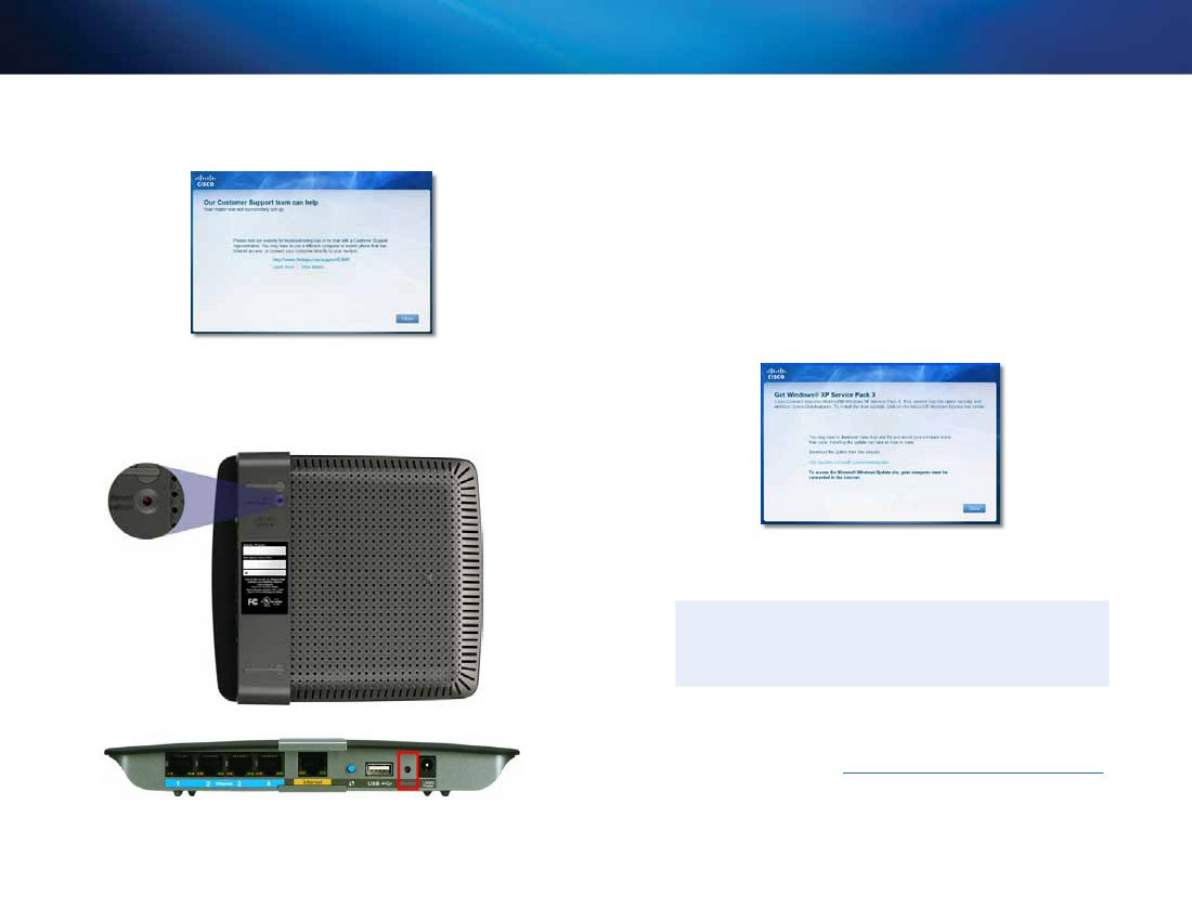
Linksys E-Series
Troubleshooting
•
Your router was not successfully set up Temporarily disable your computer’s firewall (see the security software’s
instructions for help), then run the Setup program again on the router’s
CD
If you have another computer, use that computer to run the Setup
p
rogram again on the router’s CD
•
Get Windows XP Service Pack 3 message
On Windows XP computers, Cisco Connect requires Service Pack 3 in order to
work If you receive a “Get Windows Service Pack 3” message when setting up
you
r
router for the first time, follow these troubleshooting steps
If Cisco Connect did not complete the setup, you can try the following:
• Press and hold the Reset button on your router with a paperclip or pin
for 10-15 seconds, then run the Setup program again on the router’s CD
If the currently installed Service Pack is older than version 3, you need to
download and install Service Pack 3
TIP
To temporarily connect to the Internet and download the required
Service Pack, you can use the included Ethernet cable to connect
your computer directly to your modem
To install Service Pack 3:
1 . Click the link in the Cisco Connect error message or connect to the
Microsoft Update website (update.microsoft.com/windowsupdate)
2 . Follow the instructions on the website or contact Microsoft if you need
further help
Your router’s appearance may vary 3 . After downloading and installing Service Pack 3, run the Setup program
on your router’s CD
12
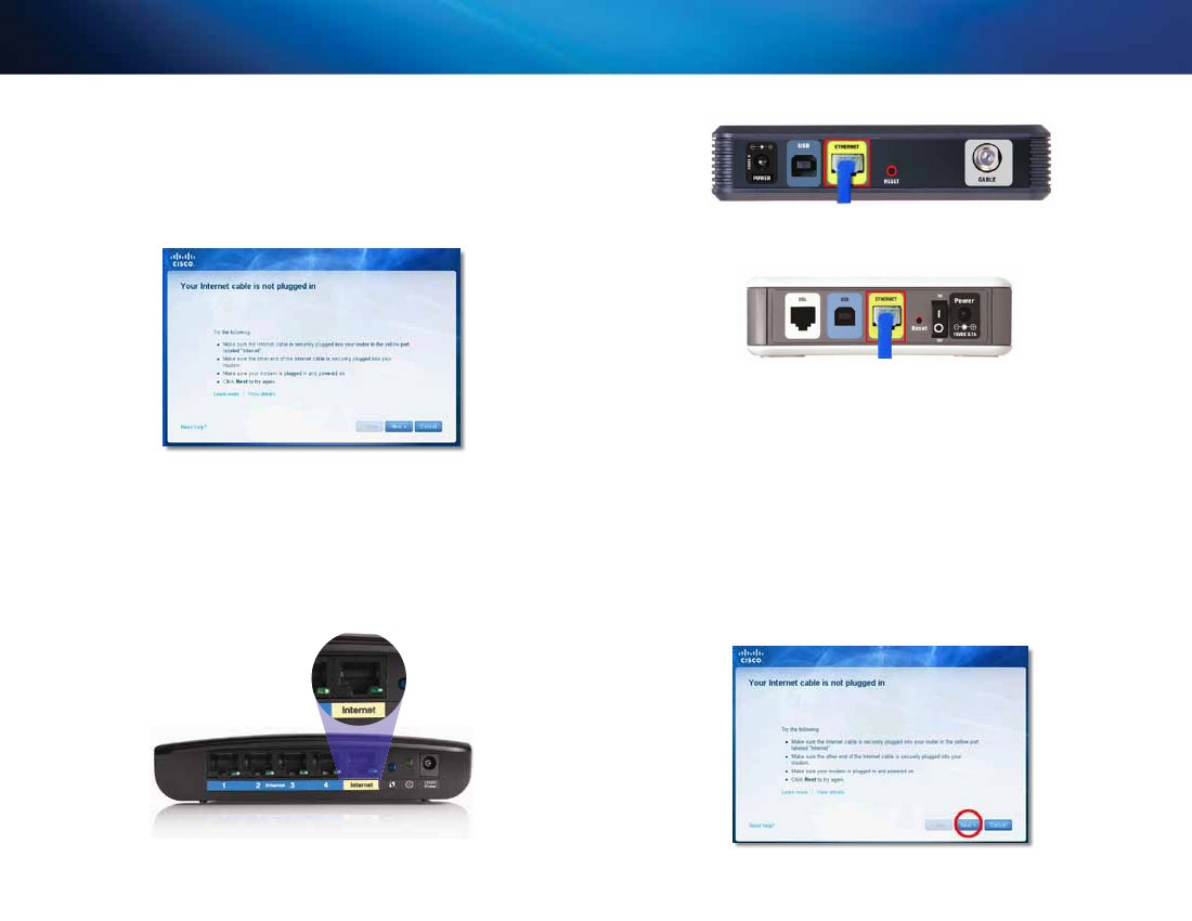
Linksys E-Series
Troubleshooting
Your Internet cable is not plugged in
message
If you get a “Your Internet cable is not plugged in” message when trying to set
up your router, follow these troubleshooting steps
Back view of cable modem
Back view of DSL modem
2 . Make sure that your modem is connected to power and is turned on If it
has a power switch, make sure that it is set to the on or l position
3 . If your Internet service is cable, verify that the cable modem’s CABLE port
is connected to the coaxial cable provided by your ISP
To fix the problem:
1 . Make sure that an Ethernet or Internet cable (or a cable like the one
supplied with your router) is securely connected to the yellow Internet
port on the back of the router and to the appropriate port on your
modem This port on the modem is usually labeled Ethernet, but may
be named Internet or WAn
Or, if your Internet service is DSL, make sure that the DSL phone line is
connected to the modem’s DSL port
4 . If your computer was previously connected to your modem with a USB
cable, disconnect the USB cable
5 . Return to the Cisco Connect window and click next to try again If the
window has already been closed, run the Setup program again on the
router’s CD
Back view of router
13
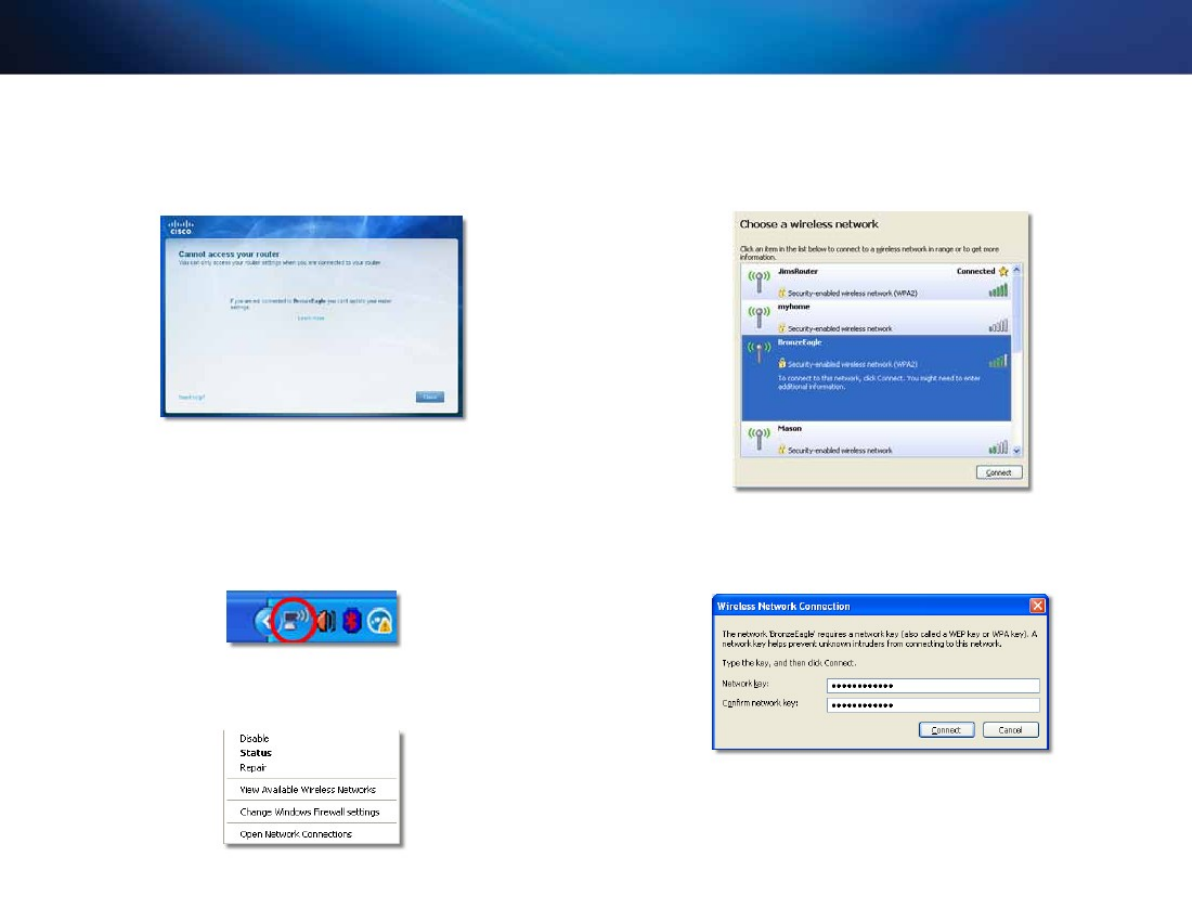
Linksys E-Series
Troubleshooting
3 . Click your own network name, then click Connect In the example
below, the computer was connected to another wireless network named
JimsRouter The name of the Linksys E-Series network, BronzeEagle in this
example, is shown selected
Cannot access your router message
If you cannot access your router because your computer is not connected to
your network, follow these troubleshooting steps
To access your router, you must be connected to your own network If you
currently have wireless Internet access, the problem may be that you have
accidentally connected to a different wireless network
To fix the problem on Windows computers:
1 . On your Windows desktop, right-click the wireless icon in the system tray
4 . If you are prompted to enter a network key, type your password (Security
Key) into the network key and Confirm network key fields, then click
Connect
2 . Click View Available Wireless networks A list of available networks
appears
Your computer connects to the network, and you should now be able to
access the router
14
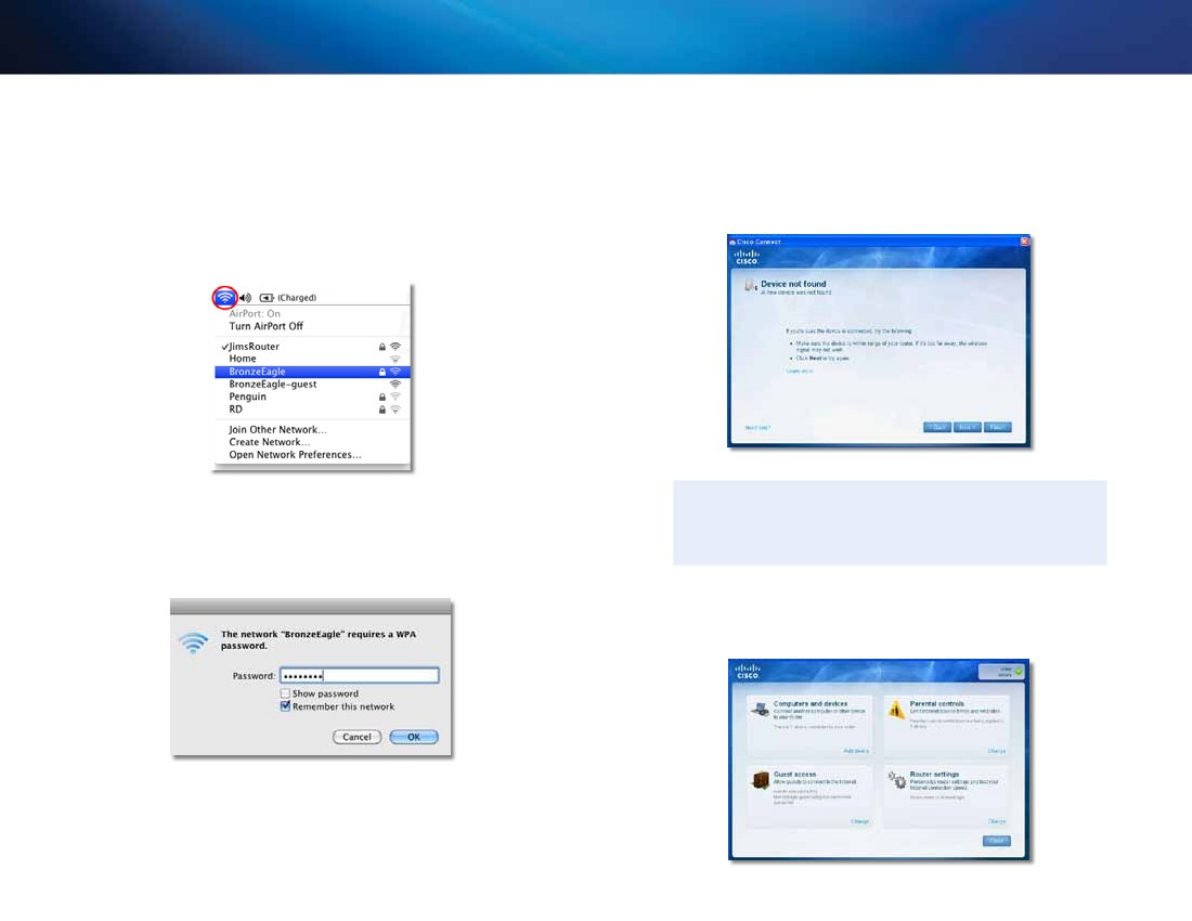
Linksys E-Series
To fix the problem on Mac computers:
1 . In the menu bar across the top of the screen, click the AirPort icon A list
of wireless networks appears Cisco Connect has automatically assigned
your network a name
In the example below, the computer was connected to another wireless
network named JimsRouter The name of the Linksys E-Series network,
BronzeEagle in this example, is shown selected
Troubleshooting
Device not found message
If you get a “Device not found” message when trying to connect a network
device (such as an iPhone, iPod, or smartphone), follow these troubleshooting
steps
2 . Click the wireless network name of your Linksys E-Series router
(BronzeEagle in the example)
3 . Type your wireless network password (Security Key) into the Password
field, then click oK
TIP
For a stronger signal during initial setup, move your wireless
devices near your router Long distances make it harder for the
router to detect the devices
To fix the problem:
1 . Run Cisco Connect
15
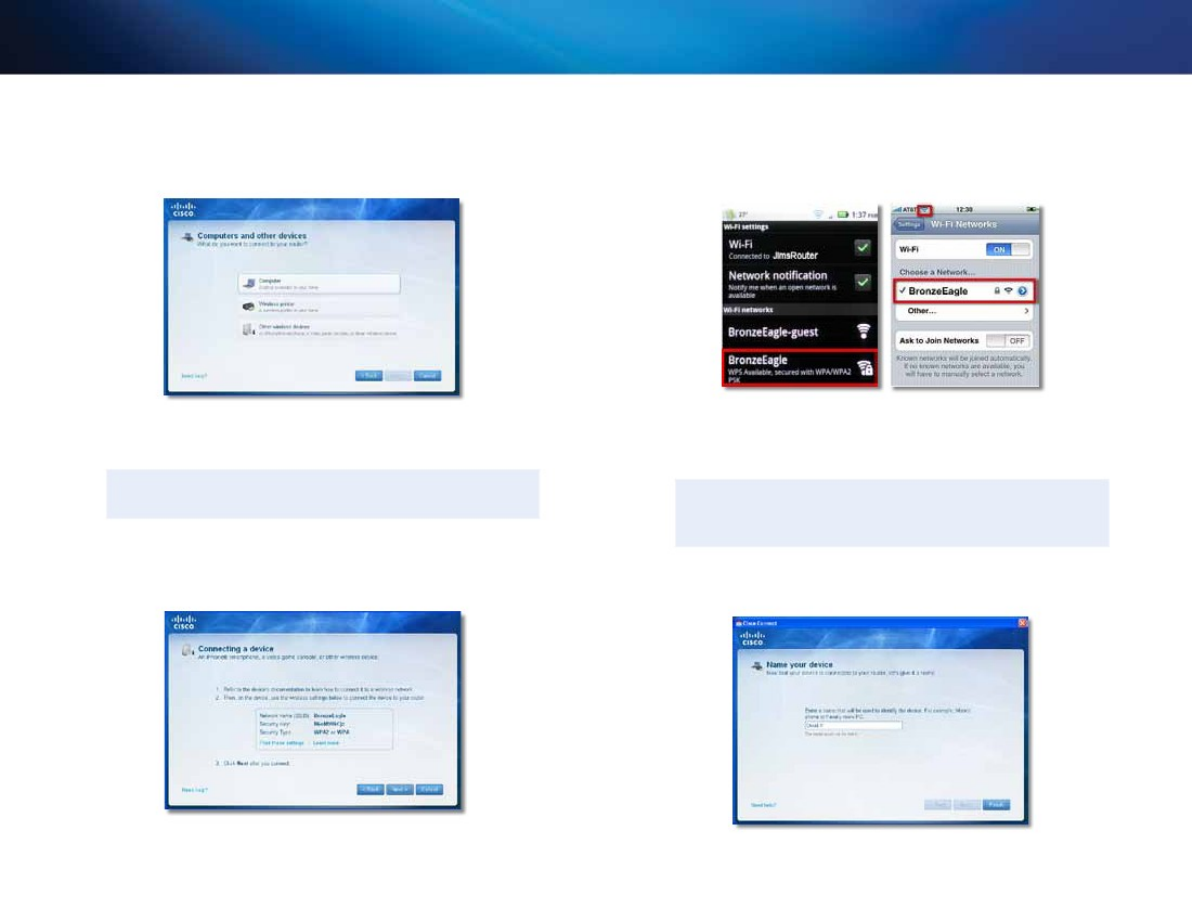
Linksys E-Series
2 . Click Computers and devices The Computers and other devices window
appears
3 . Click other Wireless devices
Troubleshooting
Example: On your Smartphone or other wireless device, locate the Wi-
Fi menu and search for available wireless networks In this example,
using the network information provided by Cisco Connect shown in the
p
revious screen, click BronzeEagle
Android iPhone
4 . Enable your wireless network device’s Wi-Fi connection, then search for
your wireless network name See your device documentation for help
N
OTE
Your wireless device must support WPA/WPA2
5 . On the wireless network device, select the network name of your router
and enter the password (Security Key)
6 . In Cisco Connect, click next
7 . Enter the password (Security Key) provided by Cisco Connect In this
example, the security key is B6eM9UkCjz
N
OTE
The password is case sensitive Make sure that you enter letters in
the correct case
8 . When your wireless device is successfully connected to your wireless
network, enter a name for the device in Cisco Connect, then click Finish
16

Linksys E1200
Specifications
Specifications
Linksys E1200
Model Name
Description
Model Number
Standards
Ports
Buttons
LEDs
Cabling Type
Transmitted Power
Linksys E1200
Wireless-N Router
E1200
802 11n, 802 11g, 802 11b,
802 3u
Power, Internet, and Ethernet (1-4)
Reset, Wi-Fi Protected Setup™
Power/Wi-Fi Protected Setup,
Internet, Ethernet (1-4)
CAT 5e
802 11n (20 MHz):
15 0 ± 1 5dBm @ CH6, MCS 0~4, MCS 8~12
13 5 ± 1 5dBm @ CH6, MCS 5~7, MCS 13~15
802 11n (40 MHz):
14 0 ± 1 5dBm @ CH6, MCS 0~4, MCS 8~12
13 5 ± 1 5dBm @ CH6, MCS 5~7, MCS 13~15
802 11g:
14 5 ± 1 5dBm @ CH6, all rates
802 11b:
16 5 ± 1 5dBm @ CH6, all rates
Antenna Gain
UPnP
Wireless Security
Security Key Bits
≤2 5 dBi, ≤4 0 dBi (2 antennas)
Supported
Wi-Fi Protected Access™ 2 (WPA2),
WEP, wireless MAC filtering
Up to 128-bit encryption
Operating Temp
Storage Temp
Operating Humidity
Storage Humidity
Power
Certifications
Environmental
Dimensions 188 7 × 151 7 × 31 2 mm
(7 43” × 5 97” × 1 23”)
Unit Weight 252 7g (8 91 oz )
12V, 0 5A
FCC, UL/cUL, ICES-003, RSS210,
CE, Wi-Fi (IEEE 802 11b/g/n),
WPA2™, WMM®, Wi-Fi Protected
Setup, Windows 7
0 to 40°C (32 to 104°F)
-20 to 60°C (-4 to 140°F)
10 to 80% non-condensing
5 to 90% non-condensing
N
OTES
For regulatory, warranty, and safety information, see the CD that
came with your router or go to Linksys.com/support
Specifications are subject to change without notice
Maximum performance derived from IEEE Standard 802 11
specifications Actual performance can vary, including lower
wireless network capacity, data throughput rate, range and
coverage Performance depends on many factors, conditions and
variables, including distance from the access point, volume of
network traffic, building materials and construction, operating
system used, mix of wireless products used, interference and other
adverse conditions
17

Linksys E1500
Specifications
Environmental
Linksys E1500
Wireless-N Router with SpeedBoost
E1500
802 11n, 802 11g, 802 11b,
802 3u
Power, Internet, and Ethernet (1-4)
Reset, Wi-Fi Protected Setup
Power/Wi-Fi Protected Setup,
Internet, Ethernet (1-4)
CAT 5e
802 11n (20 MHz):
17 0 ± 1 5 dBm @ CH6, MCS 0~4, MCS 8~12
16 0 ± 1 5 dBm @ CH6, MCS 5~7, MCS 13~15
802 11n (40 MHz):
15 5 ± 1 5 dBm @ CH6, MCS 0~4, MCS 8~12
14 0 ± 1 5 dBm @ CH6, MCS 5~7, MCS 13~15
802 11g:
18 0 ± 1 5 dBm @ CH6, 6 Mbps
17 0 ± 1 5 dBm @ CH6, 54 Mbps
802 11b:
18 0 ± 1 5 dBm @ CH6, all rates
Operating Temp
Storage Temp
Operating Humidity
Storage Humidity
Dimensions
Unit Weight
Power
Certifications
188 7 × 151 7 × 31 2 mm
(7 43” × 5 97” × 1 23”)
254 1g (8 96 oz )
12V, 0 5A
FCC, UL/cUL, ICES-003, RSS210,
CE, Wi-Fi (IEEE 802 11b/g/n),
WPA2, WMM, Wi-Fi Protected
Setup, Windows 7
0 to 40°C (32 to 104°F)
-20 to 60°C (-4 to 140°F)
10 to 80% non-condensing
5 to 90% non-condensing
Linksys E1500
Model Name
Description
Model Number
Standards
Ports
Buttons
LEDs
Cabling Type
Transmitted Power
N
OTES
For regulatory, warranty, and safety information, see the CD that
came with your router or go to Linksys.com/support
Specifications are subject to change without notice
Maximum performance derived from IEEE Standard 802 11
specifications Actual performance can vary, including lower
wireless network capacity, data throughput rate, range and
coverage Performance depends on many factors, conditions and
variables, including distance from the access point, volume of
network traffic, building materials and construction, operating
system used, mix of wireless products used, interference and other
adverse conditions
Antenna Gain
UPnP
Wireless Security
Security Key Bits
≤3 0 dBi, ≤4 0 dBi, ≤4 5 dBi
(3 antennas)
Supported
Wi-Fi Protected Access 2 (WPA2),
WEP, wireless MAC filtering
Up to 128-bit encryption
18

Linksys E2500
Specifications
Environmental
Linksys E2500
Advanced Dual-Band N Router
E2500
802 11n, 802 11a, 802 11g, 802 11b, 802 3,
802 3u, 802 3ab
4 total, 2 internal antennas per each
2 4 GHz & 5 GHz radio band
N
o
802 11b: CCK, QPSK, BPSK
802 11g: OFDM
802 11a: OFDM
802 11n: BPSK, QPSK, 16-QAM,
64-QAM
2 4 GHz
802 11b: -87 dBm @ 11 Mbps
802 11g: -70 dBm @ 54 Mbps
802 11n 20 MHz: -70 dBm @ MCS15
802 11n 40 MHz: -66 dBm @ MCS15
5 GHz
802 11a: -70 dBm @ 54 Mbps
802 11n 20 MHz: -66 dBm @ MCS23
802 11n 40 MHz: -62 dBm @ MCS23
Dimensions
Unit Weight
Power
Certifications
Operating Temp
Storage Temp
Operating Humidity
Storage Humidity
225 x 35 x 180 mm
(8 86” x 1 38” x 7 09”)
452 g (15 94 oz)
12V, 1A
FCC, IC, CE, Wi-Fi A/B/G/N
0 to 40°C (32 to 104°F)
-20 to 60°C (-4 to 140°F)
10 to 80%, relative humidity,
non-condensing
5 to 90% non-condensing
Linksys E2500
Model Name
Description
Model Number
Standards
# of Antennas
Detachable (y/n)
Modulation
Receive Sensitivity
(Typical)
N
OTES
For regulatory, warranty, and safety information, see the CD that
came with your router or go to Linksys.com/support
Specifications are subject to change without notice
Maximum performance derived from IEEE Standard 802 11
specifications Actual performance can vary, including lower
wireless network capacity, data throughput rate, range and
coverage Performance depends on many factors, conditions and
variables, including distance from the access point, volume of
network traffic, building materials and construction, operating
system used, mix of wireless products used, interference and other
adverse conditions
Antenna Gain in dBi 2 4 GHz:
Antenna 1 (right rear): ≤2 94 dBi
Antenna 2 (front right): ≤3 78 dBi
5 GHz:
Antenna 1 (right front): ≤5 86 dBi
Antenna 2 (front left): ≤4 88 dBi
UPnP
Security features
Security key bits
Supported
WEP, WPA, WPA2
Up to 128-bit encryption
19

Linksys E3500
Specifications
Storage File System Support FAT, and NTFS, and HFS+
Linksys E3500
Dual-Band N750 Router with Gigabit and USB
E3500
6 total, 3 internal antennas per
each 2 4 GHz & 5 GHz radio band
N
o
10/100/1000 Mbps
Internet, Ethernet (1-4), USB, Power
Reset, Wi-Fi Protected Setup
Power, Ethernet (1-4)
802 11b: CCK, QPSK, BPSK
802 11g: OFDM
802 11a: OFDM
802 11n: BPSK, QPSK, 16-QAM, 64-QAM
2 4 GHz
802 11b: -87 dBm @ 11 Mbps (Typical)
802 11g: -77 dBm @ 54 Mbps (Typical)
802 11n (20 MHz): -71 dBm @ MCS15 (Typical)
802 11n (40 MHz): -68 dBm @ MCS15 (Typical)
5 GHz
802 11a: -75 dBm @ 54 Mbps (Typical)
802 11n 20 MHz: -70 dBm @ MCS15 (Typical)
802 11n 40 MHz: -67 dBm @ MCS15 (Typical)
Linksys E3500
Model Name
Description
Model Number
# of Antennas
Detachable (y/n)
Switch Port Speed
Ports
Buttons
LEDs
Modulation
Environmental
Dimensions
Unit Weight
Power
Certifications
Operating Temp
Storage Temp
Operating Humidity
Storage Humidity
6 69” x 0 98” x 7 48”
(170 x 25 x 190 mm)
7 62 oz (216 g)
12V, 2A
FCC, IC, CE, Wi-Fi A/B/G/N
32 to 95°F (0 to 35°C)
-4 to 140°F (-20 to 60°C)
10 to 80% relative humidity,
non-condensing
5 to 90% non-condensing
Receive Sensitivity
N
OTES
For regulatory, warranty, and safety information, see the CD that
came with your router or go to Linksys.com/support
Specifications are subject to change without notice
Maximum performance derived from IEEE Standard 802 11
specifications Actual performance can vary, including lower
wireless network capacity, data throughput rate, range and
coverage Performance depends on many factors, conditions and
variables, including distance from the access point, volume of
network traffic, building materials and construction, operating
system used, mix of wireless products used, interference and other
adverse conditions
Antenna Gain 2 4 GHz (Dipole Antennas)
Antenna 1 ≤ 2.69 dBi (right)
Antenna 2 ≤ 3.67 dBi (left)
Antenna 3 ≤ 4.95 dBi (front)
5 GHz (Dipole Antennas)
Antenna 1 ≤ 4.73 dBi (right)
Antenna 2 ≤ 3.32 dBi (left)
Antenna 3 ≤ 3.88 dBi (front)
UPnP
Security features
Security key bits
Supported
WEP, WPA, WPA2
Up to 128-bit encryption
20

Linksys E4200
Specifications
Supported File Systems
for Storage Device
Linksys E4200
Maximum Performance Wireless-N Router
E4200
802 11n, 802 11a, 802 11g, 802 11b, 802 3,
802 3u, 802 3ab
2 4 and 5 GHz
10/100/1000 Mbps (Gigabit Ethernet)
Power, USB, Internet, Ethernet (1-4)
Reset, Wi-Fi Protected Setup
Top panel: Power
Back panel: Internet, Ethernet (1-4)
6 total, 3 internal antennas per
each 2 4 GHz and 5 GHz radio band
N
o
802 11b: CCK, QPSK, BPSK
802 11g: OFDM
802 11a: OFDM
802 11n: BPSK, QPSK, 16-QAM, 64-QAM
2 4 GHz
802 11b: -87 dBm @ 11 Mbps (Typical)
802 11g: -77 dBm @ 54 Mbps (Typical)
802 11n: 20 MHz: -70 dBm @ MCS23 (Typical)
802 11n: 40 MHz: -66 dBm @ MCS23 (Typical)
5 GHz
802 11a: -74 dBm @ 54 Mbps (Typical)
802 11n: 20 MHz: -67 dBm @ MCS23 (Typical)
802 11n: 40 MHz: -64 dBm @ MCS23 (Typical)
UPnP
Security Features
Security Key Bits
Linksys E4200
Model Name
Description
Model Number
Standards
Radio Frequency
Switch Port Speed
Ports
Buttons
LEDs
N
umber of Antennas
Detachable (y/n)
Modulations
FAT32, NTFS, and HSF+
Supported
WEP, WPA, WPA2
Up to 128-bit encryption
Environmental
Dimensions
Unit Weight
Power
Certifications
Operating Temp
Storage Temp
Operating Humidity
Storage Humidity
8 86” x 0 98” x 6 30”
(225 x 25 x 160 mm)
12 7 oz (0 36 g)
12V, 2A
FCC, IC, CE, Wi-Fi a/b/g/n,
Windows 7, DLNA
32 to 104°F (0 to 40°C)
-4 to 140°F (-20 to 60°C)
10 to 80% relative humidity,
non-condensing
5 to 90% non-condensing
Receive Sensitivity
N
OTES
For regulatory, warranty, and safety information, see the CD that
came with your router or go to Linksys.com/support
Specifications are subject to change without notice
Maximum performance derived from IEEE Standard 802 11
specifications Actual performance can vary, including lower
wireless network capacity, data throughput rate, range and
coverage Performance depends on many factors, conditions and
variables, including distance from the access point, volume of
network traffic, building materials and construction, operating
system used, mix of wireless products used, interference and other
adverse conditions
Antenna Gain in dBi 2 4 GHz (3 internal PIFA antennas)
PIFA 1 ≤ 3 31 dBi (Right)
PIFA 2 ≤ 3 45 dBi (Front)
PIFA 3 ≤ 1 96 dBi (Left)
5 GHz (3 internal PIFA antennas)
PIFA 1 ≤ 3 71 dBi (Right)
PIFA 2 ≤ 3 60 dBi (Front)
PIFA 3 ≤ 4 27 dBi (Left)
21
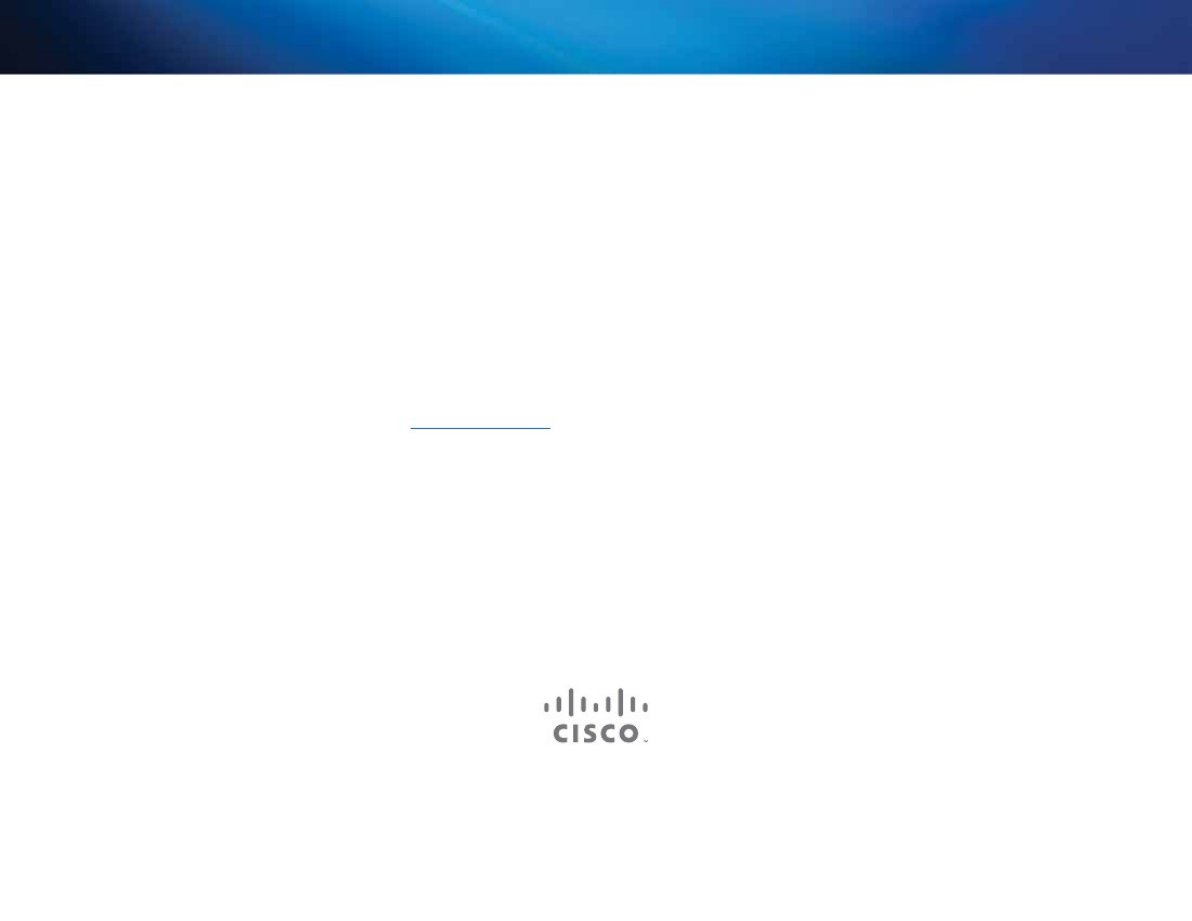
Visit linksys.com/support for award-winning 24/7 technical support
Cisco, the Cisco logo, and Linksys are trademarks or registered trademarks of Cisco and/or its affiliates in the United States and other countries
A listing of Cisco’s trademarks can be found at www cisco com/go/trademarks All other trademarks mentioned in this document are the property of their respective owners
© 2011 Cisco and/or its affiliates All rights reserved
3425-01547